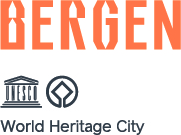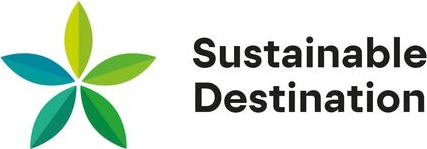The Bergen region offers a complete collection of attractions related to wool. Here, you can visit museums, factories, and fashion houses that sell modern, Norwegian-produced wool garments to the world.
The Wool Route takes you on a journey spanning thousands of years, from the Viking Age to modern design. The treeless and open coastal landscape around Bergen was shaped by the people and animals that lived here. Sheep farming in Norway and Western Norway can be traced back 5,000 years. Long before the Viking Age, sheep and wool were essential for the livelihood of coastal communities.
On the map below, you can see locations and attractions related to wool and wool production in the Bergen region. There are too many places to visit in one day, so choose your favorites and plan your visit carefully by checking opening hours in advance. The most practical way to get around is by car, but some locations are also accessible by public transport.
We begin at Lyngheisenteret on Lygra, about an hour north of Bergen. If you're traveling round trip from Bergen city center, you can take a convenient express boat in the morning and return by bus. Check schedules at Norled.no and Skyss.no.
If you’re looking for a suggested 3-day tour focusing on wool and textile production, you’ll find a detailed day-by-day itinerary in the article From yarn to sweater: Three days of wool experiences in Bergen and the surrounding region
The Heathland Centre: - a threatened landscape
The landscape along the coast of Europe has been more or less the same from Kirkenes, in the very north of Norway, to Spain, in the very south of Europe. The open landscape of coastal heathlands is now endangered. The Heathland Centre at Lygra in Nordhordland explains how people have cultivated the landscape through history by burning and harvesting the heather for fodder. They did so to ensure they had enough feed for their sheep and other livestock through the winter.

Photo: Lyngheisenteret
You can sample the Heathland Centre’s fantastic wild sheep soup, and you can also buy local food and craft products at the museum shop.
Western Norwegian Emigration Centre: Wool and culture on the move
In the 19th century there were tight conditions in the countryside of Norway. Many tried their luck an emigrated to America bringing their wool heritage with them. But many settled down in places like Salhus to work at the factory. At the Western Norwegian Emigration Centre you can learn the history of wool ended up on the prairie. In Sletta, Radøy you can visit a real prairie village that has been moved from America. Guided tours, exhibitions, cultural trail and bike rental.
Vestnorsk Utvandringssenter is located about an hour north of Bergen (or one hour from Lyngheisenteret). It is open to visitors on select days in spring and summer.
Wool factories: From mass production to modern fashion
The Bergen region is home to outstanding fashion houses that base their products on wool. All the factories are open to visitors, and each has a factory outlet offering great prices!
Hillesvåg Ullvarefabrikk
Located in Alver municipality, north of Bergen, Hillesvåg Ullvarefabrikk has roots dating back to 1898. Many of the machines used to produce wool and yarn are over 100 years old and still in operation.
At the impressive factory outlet, you can peek into the factory premises and see these machines in action, diligently producing yarn from Norwegian wool. Groups can also book a guided tour at this living Économusée. Hillesvåg Ullvarefabrikk is deeply committed to craftsmanship traditions, and everything produced here is made with care and pride, maintaining exceptional quality for discerning customers worldwide.
Norlender
In Hosanger in Osterøy, you’ll find Norlender Knitwear AS. In 1927, Ola Tveiten bought his first knitting machine for his remote farm. The factory grew, and today you can visit and purchase modern knitwear at excellent prices.
Dale of Norway
Arguably the most internationally recognized brand in Norwegian wool production, Dale of Norway’s factory is located between Voss and Bergen, about an hour from Bergen. Norwegian wool garments have been produced here since 1879, when Peder Jebsen established the first factory at the foot of powerful waterfalls. Today, you can shop for modern knitwear at the factory outlet.
Oleana
Oleana is a family-owned company founded in 1992 by Signe Aarhus, Hildegunn Møster, and Kolbjørn Valestrand, with the goal of creating new jobs in Norway’s textile industry. Their ambition is to produce beautiful garments designed and crafted with such quality that people will cherish them.
Norway has a long and rich tradition of textile production and patterned wool knitting, and Oleana is dedicated to preserving these traditions and skills by keeping production in Norway. The company is open to visitors.
Oleana is located in Ytre Arna, about 25 minutes by car from Bergen.
Janus factory outlet:
About half an hour by car from Bergen, you'll find Janus. Wool has been knitted here since 1895, and the factory is still in operation. If you want to buy some good quality wool underwear, it's worth stopping here.
The Textile Industry Museum
The knitting factory in Salhus opened in 1859, where wool was carded, dyed, and turned into garments using knitting machines. Today, you can visit the Textile Industry Museum and explore the factory’s history and the era when Norwegian wool became a mass-produced commodity. The museum café serves homemade pastries, and the museum shop offers wool products for those who want to start knitting themselves!
Wool: The Vikings’ Raincoat
About 20 minutes by car from Norlender, you’ll find Osterøy Museum, where you can learn about ancient textile and handicraft traditions.
The Vikings traveled vast distances across open seas, exposed to harsh weather. They had extensive knowledge of wool and utilized its water-resistant properties in their clothing. The longest wool fibers grow on the outermost layer of the sheep, which the Vikings wove into raincoats. This way, they could produce large amounts of clothing without slaughtering the animals.
This craftsmanship is still alive today. Osterøy Museum offers courses where you can learn how to weave your own Viking raincoat.
Stay at a traditional Western Norwegian farm
Gripen gård is an authentic Western Norwegian farm that farms sheep the old way. The farm is in a beautiful location beside Storavatnet lake on Holsnøy. Farmer Helene Olli Sollid rents out cabins on her farm as accommodation. You can also stay in a lavvo (Sami tent) on an island in the lake. Enjoy nature up close and all by yourself! You can experience the sheep at close range on the farm. The sheep are one of the oldest breeds in Norway, and can graze outdoors all year.
In the autumn, you can buy cuts of meat, cured legs of mutton and, the Christmas favourite, salted, dried mutton ribs from the farm. facebook.com/gripengard/
The wool route in a day
All the places mentioned above can be visited on a day trip from Bergen. If you want to combine several stops in one day, it's a good idea to plan ahead. Some locations have limited opening hours, and a few appreciate it if you book in advance, especially if you're hoping for a guided tour.
No matter how much time you have, you’re free to create your own route. If you only have one day, a nice combination might be visiting Oleana, Osterøy Museum, and Norlender Factory & Outlet.
In addition to these wool-related spots, you can explore beautiful Mjøsvågen on Osterøy, right next to Norlender. Here, you can pick up a simple sandwich at Mjøsvågen Landhandleri. At the far end of the bay, you’ll also find the Flabellina sauna and the charming pub Fjærå Sjøhus. If you’re up for a scenic hike, Mjøsvågen is also the starting point for the steep but beautiful trail up Kossdalssvingane.
As an alternative to the hike and Fjærå Sjøhus, you can drive on to Tøsse Brygghus and book a beer tasting - just make sure you have a dedicated driver behind the wheel to take you back to Bergen.
Meet other wool lovers at the wool festival!
Do you knit? Do you enjoy learning new craft techniques? Well, you’re not alone! The Bergen region has two festivals where the focus is on wool. We advise you to regularly check their websites as the tickets, events and workshops at the festivals sell out quickly!
Ullveka takes place every October and is a celebration of Norwegian wool, Norwegian sheep breeds and Norway’s rich textile traditions. The festival hosts many workshops, exhibitions and events across the Bergen region for over a week.
Bergen Knitfest takes place every September at the Textile Industry Museum - The Museum Centre in Hordaland. For three days on end, the museum plays host to lectures, workshops, activities and, naturally, a large yarn market.
If you need assistance planning a day trip to one or more of the places mentioned in this article, we have put together a suggested road trip along the Osterfjord, allowing you to visit several of these attractions along the way.
 to add an item to your Itinerary basket.
to add an item to your Itinerary basket.









